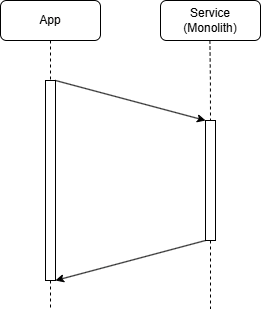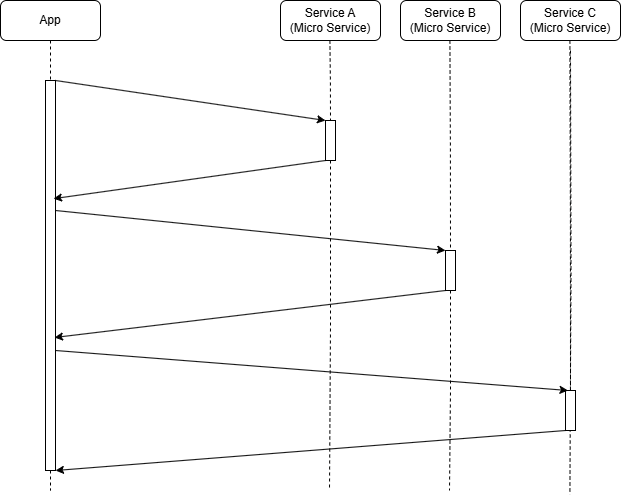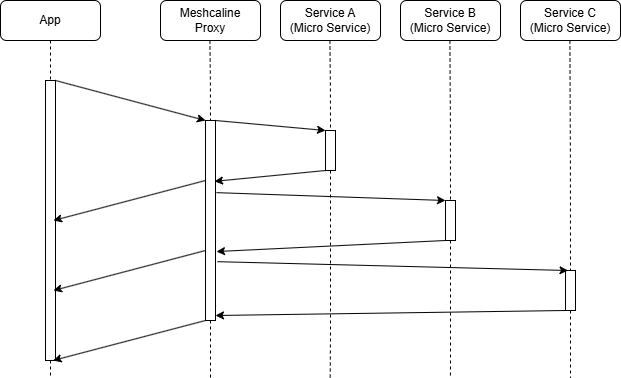meshcaline-proxy
Why Meshcaline Proxy?
The Meshcaline Proxy addresses the challenges introduced by distributed microservice architectures and offers an alternative to backend-for-frontend (BFF) architectures, which come with their own complexities.
The Evolution of Web Service APIs
The Early Days: Monolithic Web Services
Initially, web service APIs were built as monoliths, where a single system handled all business logic and provided individual endpoints for specific processes requested by their client applications.
These monoliths contained all the necessary capabilities to implement their business processes.

However, as businesses grew and processes became more complex, these monoliths became difficult to maintain, modify, and scale.
The Rise of Microservices
The microservice architecture addresses monolithic limitations. Instead of a single, complex system, business processes are broken down into self-contained microservices, each responsible for a specific function. This results in:
- Smaller, more manageable codebases
- Improved performance by optimizing each service for its task
- Greater reusability of services across different business processes
However, a major drawback: client applications now have to handle service orchestration.
The Challenges of Microservices for Clients
In a microservice-based system, client applications must compose multiple service calls to implement a business process. While developers are capable of handling this orchestration, it introduces significant performance issues, particularly for mobile applications.
The Problem of Network Latency
In a monolithic system, a client might only need one or a few requests to the backend. In contrast, microservice-based architectures require dozens of requests, many dependent on previous responses. Given that these requests travel over the public internet, especially on mobile networks, latency becomes the main bottleneck rather than server processing times.

Network latency is a fundamental limitation of physics. The speed of light defines the upper limit – for instance, it takes approximately 100ms to transfer a single bit between Frankfurt and New York. No server optimization can overcome this physical constraint.
The Problem of Over-Fetching Data
Microservices are often designed for broader business domains, not just a single client use case. As a result, they tend to return more data than needed in a specific context, wasting bandwidth and further increasing latency.
Backend-For-Frontend: A Middle Layer Solution
To mitigate these issues, the Backend-For-Frontend (BFF) pattern emerged. A BFF service sits between the client and microservices, handling orchestration and filtering unnecessary data. Because BFFs are usually hosted close to microservices, they significantly reduce network latency.

The Downsides of BFFs
While BFFs solve latency and over-fetching problems, they introduce new challenges:
- Development Bottlenecks – Client teams depend on BFF teams to implement new functionality, leading to delays.
- API Design Misalignment – BFF APIs often diverge from the microservice APIs they rely on, making updates difficult and requiring costly redesigns.
- Scalability Issues – Over time, maintaining and evolving a BFF architecture becomes complex as more microservices and business processes are introduced.
GraphQL: A More Flexible Alternative?
GraphQL, becoming popular around 2015, allows to address some of the BFF limitations by allowing clients to query only the data they need using a standardized query language. However, it comes with its own drawbacks:
- Clients lack visibility into how queries are processed, sometimes leading to performance bottlenecks.
- GraphQL requires a global type system, often conflicting with evolving microservice data models.
Introducing Meshcaline Proxy
The Meshcaline Proxy provides a flexible and scalable alternative to BFFs by acting as a lightweight orchestration layer rather than a separate API.
How Meshcaline Proxy Works
Instead of a dedicated service maintained by a separate team, Meshcaline Proxy is a generic infrastructure component that:
- Orchestrates multiple web service calls based on instructions provided by the client.
- Filters unnecessary data before sending the response back to the client.
- Keeps the client in control, avoiding the rigidity of BFF implementations.
- Enables responsive UI, by streaming individual sub-resources independently

Unlike GraphQL, Meshcaline Proxy does not enforce data model transformations, allowing microservices to evolve independently while still optimizing client responses.
Is This the End of BFFs?
Not necessarily, but Meshcaline Proxy eliminates the need for many BFF use cases.
When BFFs are used for business logic separation, they remain valuable. However, if the main reason for a BFF is reducing latency and optimizing client requests, Meshcaline Proxy is a more efficient and scalable alternative.
Complementing BFFs with Meshcaline Proxy
Even in cases where a BFF is needed, Meshcaline Proxy can enhance its capabilities:
- Maintains clean, client-agnostic business logic in the BFF.
- Optimizes request orchestration based on client needs, without modifying the BFF itself.
And there is more…
Beyond Proxied Microservices: External Orchestration
Meshcaline Proxy can orchestrate calls to external services beyond microservices within a company. For example:
- A service returns an address.
- The client needs geolocation coordinates.
- The proxy can automatically fetch data from Google’s Geocoding API and combine the results.
Because the proxy operates on a high-speed data center network, it can complete this task much faster than a client device, reducing latency.
Implicit support for Meshcaline API design principles
Webservice API that follow the Meshcaline hypertext-control design are implicitly supported and dramatically simplify the orchestration instructions that the client has to send. Rather then being forced to specify how to construct a subrequest given the information returned in the previous response, the client just has to indicate which hypertext controls to follow and the proxy will construct the subrequest automatically.
Conclusion
The move from monolithic to microservices architectures introduced new challenges in client-side orchestration and performance optimization. While BFFs emerged as a solution, they introduced bottlenecks and rigid dependencies.
Meshcaline Proxy provides a lightweight, flexible, and scalable alternative, allowing client applications to efficiently compose microservices without the downsides of traditional BFF architectures.